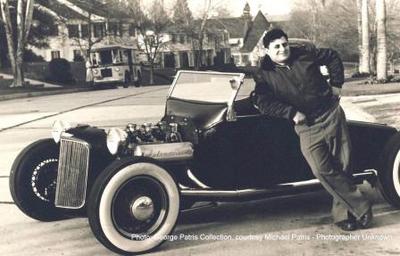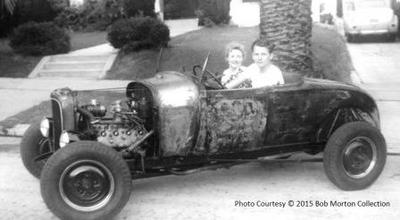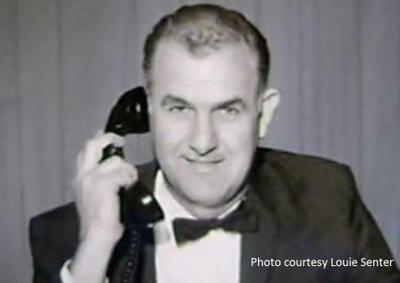Tribute To Dick "Goldie" Guldstrand And Other SoCal Hot Rodder Pioneers of Power & Speed; By Steve Ford, The Car Guy®
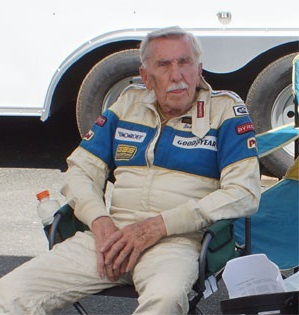 Dick Guldstrand |
See Also Dick Guldstrand Story Archive
By Steve Ford – The Car Guy®
West Coast Contributor
The Auto Channel
Among the reflections we have seen as we start into
‘2016’ are the recaps of stars and luminaries we lost in the
past year – and some exceptionally bright lights certainly
disappeared. From the entertainment world we lost Leonard Nimoy and the
wisdom and that intergalactic logic of Spock from Start Trek – and in
the sports world we lost the one-of-a-kind humor and wit of icon Yoggi
Berra. In the automotive world we also bid farewell to a few more of our
own leaders of the pack – and one of our best was Dick
“Goldie” Guldstrand.
 Dick Guldstrand |
“Cars and motorsports” – Some people do it for the money, some do it for the fame, and some do it for the best of their own abilities. In the process of harnessing torque and unleashing horsepower, the late Dick Guldstrand did it first from his own love of speed. He went on to inspire others as he shared his talents as a professional race-car driver in competition and enhanced the industry along the way with his unique engineering contributions.
With Goldie’s departure last year at 87 years old, some might say he crossed his finish line with a checkered flag. It seems to me that he may have finished his race and ‘pulled into the garage’, but the force of his wind on the track carries on. Everyone who knew Dick personally, or knew of his journey and achievements, has to miss his presence on the planet.
The positive impact of Guldstrand’s life continues in a truly profound way – and his legacy strikes me as worthy of being recognized as a genuine role model for generations. He came from an enclave of pioneering Southern California gearheads who changed the world by igniting a sub-culture of hot rodding while tinkering in their home garages. These guys literally hand-fabricated their cars without today’s ease and relative simplicity of ordering engines, drivelines, accessories and suspension parts off the shelf from online outlets or through speed catalogs.
“I was just very fortunate to be a Southern California hot rodder and to have the privilege of all these wonderful people who taught me the engineering side of how the hell to keep a car together,” Guldstrand once told me in an interview. “Because it really wasn’t easy back then. You had no money and all you had was your two hands and a welding torch.”
In fact, when you swoop way back to the 1930s into the 1940s when these guys were hanging out with each other prior to the earliest of the speed shops in Los Angeles, the term “hot rod” hadn’t even been invented. When I spoke with legendary camshaft grinder, Ed “The Camfather” Iskenderian, founder of Isky Racing Cams, he said that when he was a teenager in the mid-1930s they used to call hop-up cars by an earlier made-up name: “Gow Jobs”.
“We’d see a fast car go by and say, ‘that car’s got a lot of gow,’ which meant ‘get up and go’ – and that became ‘gow’. So when I was growing up, we didn’t even have the term ‘hot rod’,” Iskenderian added.
ARRIVAL OF “HOT ROD” SUB-CULTURE
SoCal Speed Shop founder and land speed legend Alex Xydias noted that early hot rodders were first considered more renegades than role models. “When we first heard the term ‘Hot Rod’ arrive, it was really a mostly a derogatory title because of the early newspaper reports that came out and they used the term ‘hot rods’ negatively, as they related to street racing,” Xydias said.
“And, of course, it was Pete Petersen who really had the insight to go with his magazine by that name (‘Hot Rod’, first published in 1948),” Xydias added. “But we didn’t consider something a real ‘Hot Rod’ unless someone actually did something significant to modify the car – such as putting a later model V8 into an earlier Ford Model A.”
In the 25th Anniversary issue of Hot Rod magazine, senior editor Steve Kelly observed that the roots for the term ‘hot rod’ very likely came from the combination of ‘hot’ and ‘roadster’, both terms that had emerged in early automotive “hop-up” culture in the 1920s. Reflecting on his earliest memories, Isky noted, “I do also remember hearing another similar term at that time – ‘hot iron’. They’d also say, ‘they’re driving some hot iron.”
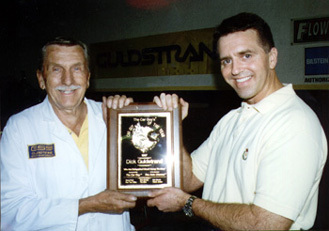 Dick Guldstand receiving the 1997 “Car Guy of the Year” award from Steve Ford and sponsored by The Auto Channel. |
Revisiting history can sound like reminiscing about a different time, and certainly it was, yet the kind of character that these role models reflect is as relevant today as ever.
When The Auto Channel co-publisher Bob Gordon asked me if I would like to write an editorial on a reflection about 2015 and the passing of legendary Dick Guldstrand among others, I welcomed his invitation. After all, it was The Auto Channel that joined to sponsor the special plaque and announcement publicity support of Dick Guldstrand to be formally voted and named The Car Guy of the Year title back in 1997.
“We were proud to help salute Dick Guldstrand as one of most accomplished heroes of the motorsports and car culture communities, and we feel like we’ve lost a friend,” said Gordon. “We had a memorable time with him and were even fortunate enough to have TV legend and fellow ‘car guy’ Tim Allen join as guest in the program to deliver the announcement as a surprise to Dick during a radio/webcast of The Car Guy Show here on The Auto Channel!”
HEROES, ROLE MODELS WELCOME – APPLY WITHIN
Heroes, true heroes – those inspiring and original innovators and folks who are courageous enough to do things they believe in, even when others may view their efforts as daydreaming, are hard to find today. Dick Guldstrand was someone whom I considered a genuine hero and part of a special breed of “can-do” Americans who project a timeless message for all of us: Work hard to discover your own unique gifts and continually grow and contribute to polish your talents beyond your comfort zone.
Guldstrand once said that one of the most memorable tests outside of his own ‘comfort zone’ was when he raced to sustained speeds approaching 180 mph on the 3.5-mile Mulsanne straightaway in the 24 Hours of Le Mans. “Driving an L88-powered Corvette with the blur of guardrails within feet of your front fenders at those speeds was a whole new level of fear for me to overcome,” he said with a laugh.
Today we have dozens of great new celebrity car builders and custom-car TV “stars” who are extremely talented. Yet the millions of new-generation car buffs in today’s national TV audiences can benefit from being reminded that “once upon a time” there were only a few dozen hot rodders who had no TV, or even the first of the eventual variety of hop-up car magazines.
CAMARADERIE AND THE LANGUAGE OF HORSEPOWER
The ‘social media’ of the earlier 20th century car community for Guldstrand and these innovators was not because of a wireless Internet connection, but the priceless link among humans through their universal language of speed and horsepower. And “Goldie” (his eventual road-racer nickname) became one of the leading ambassadors of motorsports and aftermarket performance.
In today’s car-enthusiast community, we can’t cast too large a spotlight on the past and present legends of hot rodding whose ‘skinned knuckles’, life-risking experiments and breakthroughs for increased speed and performance established the foundation of today’s hot-rod culture.
Whether you are a long-time industry and motorsports veteran, or a relative newcomer to the world of wheels, it’s worthwhile to pause and celebrate our good fortune to have a remaining handful of living legends who were “there at the start”. On any Saturday morning in communities across the nation, gatherings of car enthusiasts can be found getting together for coffee or breakfast to catch up on their journeys and enjoy the unique camaraderie inside the world of wheels.
 Breakfast with the pioneers of hot rodding and the best of Southern California car culture. Dick Guldstrand and friends at his favorite Burbank, Calif., coffee shop |
This past summer, I was privileged to join ‘Goldie’ along with my own high school auto shop teacher, Lee Mills (Granada High School, Granada Hills, Calif.), to gather at one of our own local breakfasts with fellow car guys. After a few more phone calls, we were able to add several more of the original living heroes of Southern California car culture. We converged at one of Goldie’s favorite Burbank, Calif., coffee shops along with Louie Senter (co-founder of Ansen Speed Equipment, 1947) and fellow hot rod enthusiast Bob Leggio; Alex Xydius (founder of SoCal Speed Shop, 1946); Bob Morton (Ansen Speed Equipment employee, 1946-1951) and Ed ‘Isky’ Iskenderian (founder of Isky Racing Cams, 1946).
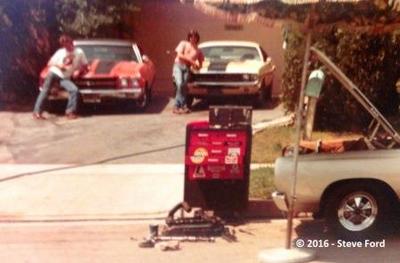 A by-product of the hot-rod culture was the speed parts and accessories aftermarket – and an endless menu of hop-up projects for next-generation ‘Auto Shop’ students to enjoy. |
When I was a high school automotive student, the names of these individuals and other leaders like them were familiar to me as legends behind premier performance-aftermarket brands or heroes of motorsports; in some cases, they were both. Reflecting on that last breakfast with Dick Guldstrand and these other special pioneers of hot rodding just a few months back, I knew that reaching out to them for reflections about him today would be meaningful.
RECOLLECTIONS ABOUT GULDSTRAND & EARLY SPEED-SHOP DAYS
“I always admired Guldstrand because this business is a bit about bluffing and publicity to capture the imagination,” Iskenderian said. “And I used to marvel at the original and creative suspension terms that he made up himself. But they picked up his terms and I’m pretty sure that some of the suspension terms we hear today are from him,” he added. “You know, a little bit of salesmanship and you grab the horns and become the leader – and he did just that! Of course, he truly understood and improved suspensions. That was his gift.”
Early race-engine and hot-rod builder Bob Morton knew Guldstrand from their teenage years across a lifetime friendship and holds fond memories back to their first days with cars. Morton explained that they shared roots to that time when the earliest hot rodders were tricking out production engines from family sedans by milling cylinder heads for higher compression ratios, running higher-lift camshafts and experimenting with early variations of multiple-carburetors.
“We used to have locals from the early hot rodding community hang out together – and Dick was one of the guys who’d stop in regularly at Louie Senter’s speed shop (Ansen Speed Equipment) and that’s where I met him. You’d find teenagers like Guldstrand and Ed Pink and others showing up at Ansen’s – we were some of Louie’s earliest customers,“ Morton recalled. “I went to work for Ansen when I was 15 years old, in 1946, and would hang out there and see Dick and others around there while I worked at Ansen’s until 1951. That’s when I joined the service,” Morton added.
Louie Senter’s Ansen Speed Equipment contributed a stream of industry innovations to the aftermarket. Just a sampling included the first aftermarket conversion kit from steering-column to floor-mounted shifters and the first steel “scatter shield” to replace softer cast-iron bell housings (and help protect drivers from flywheel or clutch explosions). Senter also produced advancements and innovations such as forged aluminum pistons, and aluminum connecting rods and aluminum rocker arms, as well as one of the first production stroker (increased stroke-length) crankshafts, and many more parts and accessories. The famed company was an early leader in catalog sales and mail-order speed parts, starting in the later 1940s.
Looking back on Guldstrand’s nature and character, Morton said, “Dick was the kind of guy who was there to take care of his wife and his family as best he could – and he was absolutely one of the best friends I ever had,” he added. “And he figured out those suspensions and let me tell you, nobody was beyond him on setting up cars to hold the road!”
THE FATHERS OF HOT RODDING & MENTORS TO THE ‘PIONEERS’
Iskenderian noted that even as he and Guldstrand and others learned and exchanged ideas with innovators like Louie Senter (who was also one of the first retailers to sell Isky Racing Cams), they also actually looked up to an earlier generation, too. “After Louie made parts in his home garage machine shop, he went on to work for Eddie Meyer in Hollywood for a time. And Eddie Meyer is a name people should know too,” Iskenderian noted.
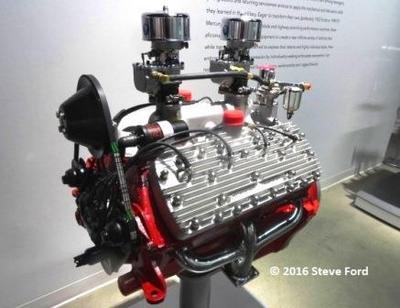 From its first arrival as a mainstream production engine from Ford Motor Company in 1932, the famed ‘Flathead’ V-8 was destined for a central role in American hot rodding hop-up tricks and the huge growth of the automotive aftermarket |
Of course, now we’re going way back – in Eddie Meyer’s case we need to go back to 1919! Meyer started by opening a general repair shop specializing in Ford Model Ts out of Redlands, Calif. By the late 1920s Meyer relocated to Hollywood where he became an early innovator with hop-up tricks for Model Ts – and continued his leadership later with power upgrades for the famed Ford ‘Flathead’ V8.
 As one of the most accomplished and humble “ambassadors” of car culture and hot rodding today, Ed “Isky” Iskenderian shares camaraderie across generations. |
Into the 1930s and 1940s and beyond, Meyer (who was also brother of three-time Indianapolis 500 winner Louis Meyer) and another legendary name of Vic Edelbrock, Sr., were two of the most prominent purveyors of horsepower and speed equipment for the burgeoning L.A. hot rod scene. Yet Iskenderian told me that a story about early days of engine hop-up legends would be incomplete without mentioning his mentor, Ed Winfield, who is often referred to as “The Father of Hot Rodding.” Iskenderian explained that Winfield was known as the man to go to for the best carburetors, cylinder heads and camshafts in the business and, in fact, took a liking to the younger Iskenderian as a customer, and eventually became his early mentor.
“Winfield was the guy who was always ahead of all of us,” Iskenderian said. “He knew just about everything there was to know (about how to make horsepower) and he was a self-taught man.”
It now becomes easier to see why pioneering speed parts merchant Alex Xydias applied his keen sense of timing to open his own SoCal Speed shop in Burbank, Calif., in 1946 (only days after his discharge from military service in the U.S. Army Air Corps). Like so many during the WWII years of 1941 to 1945, Xydias and others were also influenced by living in close proximity to the advanced manufacturing, production and aviation companies operating in Southern California.
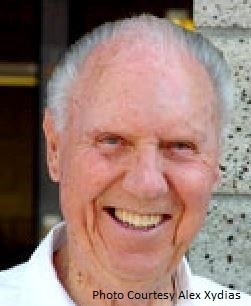 Alex Xydias |
As a role model of innovation
in both merchandising speed parts and established land-speed records, Alex
Xydias continues to inspire generations today via the Alex Xydias Center
for Automotive Arts in Pomona, Calif
AEROSPACE INVENTION & LAND SPEED EXPERIMENTATION
This increased the sophistication of workers’ machining, milling and fabrication techniques – all migrating as literal cutting-edge advancements into the engines and chassis of the coolest new L.A. roadsters. Along the way, other brilliant innovators were coming into the new game – Vic Edelbrock, Jr. was coming up under his father’s mentorship (and Vic, Jr., is one of the most successful and innovative aftermarket performance leaders today). And the list of names grew even more rapidly from the ‘40s and ‘50s, as did the parallel need for safer off-street racing.
The constant temptation of early hot rodders to test their machines in speed contests at stop lights on city streets has always led to lost lives and danger to innocent bystanders. It followed that even in the earliest years of the ‘20s, ‘30s and ‘40s, racers gravitated to open and more remote areas for safer speed contests by the 1950s.
For a period, the earliest hot rodders went up to the dry lakes in the Mojave Desert, north of L.A., including the famed Muroc and El Mirage sites. The dry-lakes culture of land speed records led to formal organizing bodies, including the Southern California Timing Association (S.C.T.A.) for safety, rules and officially sanctioned speed records. Yet beyond the long travel distances to these sites, Muroc and other desert areas were eventually taken over by the Army Air Corps and other aerospace manufacturing entities.
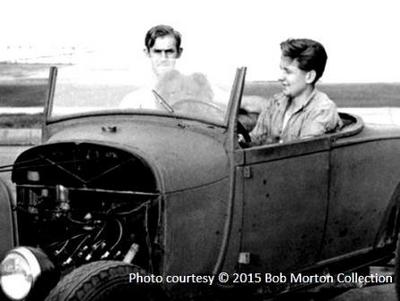 Speed parts merchant Louie Senter (L) with teenage employee Bob Morton (R) was a teacher and mentor to future stars of America drag strips and car careers. |
What is known today as John Wayne Airport was previously the birthplace of the American drag strip when a visionary young hot rodder name C.J. “Pappy” Hart established the first organized drag races. When Hart took his vision of a whole new purpose for an abandoned auxiliary air strip in the then-unpopulated region of Orange County, Calif., in 1950 he established the quarter-mile race track as Santa Ana Drag Strip. Just a year later, in 1951, another pioneering visionary hot rodder named Wally Parks started the National Hot Rod Association (NHRA) to formalize the new sport of drag racing. By the time Santa Ana Drag Strip closed in 1959 due to suburban encroachment, drag strips had sprung up from coast to coast.
HORSEPOWER AND PASSION HEARD AROUND THE WORLD
Who could have envisioned a small group of American teenagers in Southern California experimenting with “hop-up” tricks on cars and igniting a hot-rod craze that would go ‘worldwide’? For Guldstrand’s part, he once told me that his “Auto Shop” class experience at Los Angeles High School was pivotal to his discovery of his passion and the foundation for his “hands-on” career.
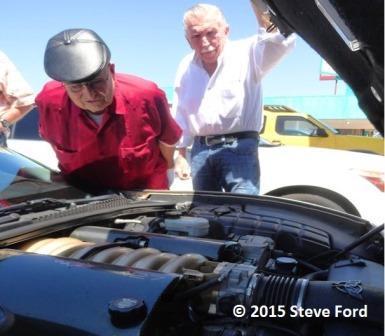 The ‘Camshaft’ master chats with the ‘Suspension’ wizard in 2015. Perhaps there is no better sight than two world-class hot rodders talking about “what’s under the hood”. Dick Guldstrand (R) shows Ed “Isky” Iskenderian the custom-built 427 engine in his 50th Anniversary Corvette. |
While we can’t expect every student to enter an automotive career or become a DIY-er, every youth can benefit from hands-on skills and knowing a Phillips screwdriver from a pair of pliers. Meanwhile, inside car culture we have all benefitted from the pioneering spirit, courage and brilliant innovations from what was once just a cadre of Southern California hot rodders. We salute you, Mr. Dick Guldstrand, and to all of the past and present pioneers of speed and power – whether luminaries in the headlines or our next-door neighbors who “fix” things today in your home garages. We look up to you and thank you for your shining examples!
© 2016 Steve Ford – The Car Guy®
VIDEO: Steve Ford "The Car Guy®" takes you along as he visits and lovingly interviews Hot Rod's "pioneers of power & speed”:
Dick Guldstrand – “Mr. Corvette”
Ed “Isky” Iskenderian – “The Camfather”
Louie Senter – “Mail Order Horsepower”
Steve Ford – The Car Guy® is a three-time Gold-level IAMC award-winning journalist and periodic contributor to The Auto Channel®. In ongoing professional work as a broadcast journalist, he is also a nationally certified ASE-Master Automotive Technician/Trainer and credentialed instructor with and M.A. in Educational Technology from Michigan State University. In volunteer work he contributes to skilled-trades and youth-careers outreach programs as a part-time automotive technology instructor and career planning/motivational speaker to schools and youth-correctional institutions: www.TheCarGuy.com.
Chevrolet Corvette Influential Personalities Dick Guldstrand And Others - 1993-2016 Corvette Microsite +VIDEO
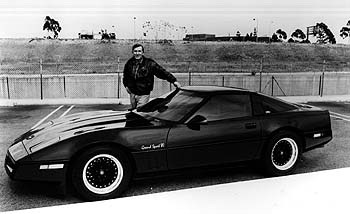 Chevrolet Corvette And Dick "Goldie" Guldstrand |
SEE : Chevrolet Corvette News, Video, Opinion, 1993-Present
SEE: Chevrolet Corvette Specs 1997-2016
Corvette People: A Look at the Talent and Personalities That Brought Corvette to Life
DETROIT - August 8, 2002; Over the last half-century, thousands of gifted, intelligent men and women have contributed to the Corvette legacy. Any attempt to whittle the list down to a dozen or so Corvette "people" is a daunting effort at best, sure to offend those who aren't included. At Corvette's roots are the legendary GM designers and executives such as Ed Cole, Bill Mitchell and Harley Earl. Without their vision, perseverance and insight, the Corvette would never have made it past the initial sketches. Since then, scores of others have given droplets, or buckets-full, of brilliance to the cause. Some fought hard when people in power were determined to kill the car. Others worked the details, toiling into the wee hours designing and redesigning, testing and retesting and then finally building the car. And still others proved the car, in the wind tunnel, on the test track and on the racetrack. Each gave a little bit of spirit and whole lot of soul. All made a difference. So, with all due respect to these unsung talents, here are just a few of those who helped make the Corvette an icon.
Harley Earl. The Corvette was the brainchild of Harley Earl, GM's first design chief. Earl loved sports cars, and he noted that GIs returning from World War II were bringing home European roadsters. Earl convinced GM's top executives that they needed to build an inexpensive American two-seater.
Originally code-named "Project Opel," the Corvette project was kept under tight wraps in a small studio, where a handful of people worked on it. Initially, Earl wasn't sure which GM division should sell the Corvette, but he decided to give Ed Cole's Chevrolet Division first shot. Cole knew the first time he saw the prototype that it was just what Chevrolet needed to give the brand a new image.
Earl's Corvette debuted at Motorama in New York, January of 1953 and was an instant hit. Six months later the Corvette went into production.
Zora Arkus-Duntov. When Zora Arkus-Duntov arrived at GM in May 1953, he had an agenda: to make the Corvette the performer he knew it could be. Arkus-Duntov first saw the Corvette at the 1953 Motorama in New York City, and it so inspired him that he wrote a letter to Ed Cole, sharing his desire to work on the car. His vision, energy and determination shaped the early years of the Corvette legend, and that spirit continues to drive the destiny of the sport coupe even today.
In 1956, an Arkus-Duntov camshaft, mated to Cole's small-block V8, boosted horsepower from 195 to 240, and Arkus-Duntov set a record behind the wheel of this Corvette, doing the Daytona Flying Mile at 150.583 mph. He also set a stock car record when he raced up Pikes Peak in 1956 in a pre-production prototype Chevy. In 1963, Zora launched the legendary Grand Sport program. The idea was to create a special lightweight Corvette weighing only 1,800 pounds and race it on an international circuit. By 1968, he'd become chief engineer of Corvette, and helped introduce technology such as disc brakes, independent rear suspension and limited-slip differential. He developed the famous Duntov high-lift camshaft and helped bring fuel injection to the Corvette in 1957. He also pioneered the CERV experimental research vehicles, a moniker still in use today.
Yet his life in America was just a fraction of the Zora story. Born in Belgium on Christmas Day in 1909, he graduated from the Institute of Charlottenburg in 1934, and started writing engineering papers for a German publication. In 1939 he married Elfi Wolff, a German native who danced with the Folies-Begère. They later escaped Europe when France surrendered, with Elfi piloting an MG, Nazi troops in close pursuit, and Zora cloistered in a bordello until the danger subsided. Several days later they set sail for New York. There, Arkus-Duntov and his brother, Yura, started a business that manufactured parts for Ford and the military. Later, he worked on the Allard sports car in England, co-driving it at Le Mans in '52 and in '53, and then winning class victories at Le Mans in 1954 and 1955 in a 1100cc Porsche Spyder.
Arkus-Duntov retired from GM in 1975, but remained intimately connected to the Corvette culture until his death, just months before the 1997 launch of the fifth-generation model. He was a fixture at most of the major Corvette gatherings, shows and events, and was always accessible to the car's many loyal owners.
"The one impression I'll cherish is the warmth," said John Cafaro, chief designer for the fifth-generation Corvette. "Zora was held in such high esteem in Corvette and automotive circles. Yet, he'd sit there for hours and hours signing autographs. He always had time to devote to Corvette lovers."
Passionate, opinionated and brilliant, it's fair to say the Corvette's soul will always belong to Zora.
Dave McClellan. Six months after staff engineer Dave McClellan joined the Corvette team in 1975, he took on a most daunting challenge when he assumed the role of Corvette chief engineer after Arkus-Duntov's retirement. It didn't help that Corvette's future was uncertain, at best. Caught in the crossfire of tightening federal regulations and the fuel crunch, cars like Corvette were quickly becoming an endangered species. But McClellan, with a strong performance car background at GM, was ready.
Unafraid to push the limits of technology, the 1978 hatchback coupe debuted under his watch, and after that, the fourth-generation Corvette. The first 140 mph Corvette in more than a decade, McClellan and his team made sure the car met tough speed, handling and aerodynamic criteria in an era of strict regulation, and satisfied legions of Corvette owners in the process.
During McClellan's tenure, he and his team introduced groundbreaking new technologies such as ABS, traction control, passive keyless entry, extended-mobility tires, and air bags, many of which soon became standard and optional fare on the rest of the Chevy lineup. He also raised the car's horsepower by 50 percent and refined the handling and fuel injection.
In addition, McClellan oversaw Corvette's stunning run in endurance racing. Drivers like Kim Baker, Tommy Morrison, Dick Guldstrand, Doug Rippie and John Powell piloted the Corvettes to win 19 of 19 SCCA endurance races in '85, '86 and '87, until it was dismissed from SCCA competition.
Another major accomplishment for McClellan was the development of the venerable ZR-1, the King of the Hill, a car some believe is the best Corvette in history. He and his team also began the legwork for the fifth-generation Corvette before the end of his run as chief engineer. Considered a "quiet genius" by many, he retired from GM in 1992 after 17 years at the helm, but not before the 1 millionth Corvette rolled off the line at the Bowling Green plant in Kentucky.
Dave Hill. As the third chief engineer in Corvette history, and the present commander-in-chief, Corvette vehicle line executive Dave Hill made a huge statement with the fifth-generation Corvette coupe and convertible, and the over-400hp Z06. Certainly one of the most-anticipated vehicles in the 1990s, the stakes were high for the new Corvette, and Hill delivered a critically acclaimed car that paid homage to the rich heritage, while satisfying modern safety, comfort and performance requirements.
Under his watch, Corvette pioneered the hydroformed frame rail, achieving a lighter, stiffer, better handling vehicle. Hill and his team also made major improvements in visibility, noise, vibration and harshness, build quality and performance.
He came from Cadillac, where he was chief engineer on Allante, and today he heads up the Cadillac XLR program in addition to fifth and sixth generation Corvette programs.
As the current ambassador of the Corvette legacy, Hill also is very involved in the events and activities the surround the car. A regular at Corvette car shows, races and museum events, Hill is a celebrated, well-known fixture in the Corvette community.
Bill Mitchell. Quite possibly one of the greatest automotive designers ever, it's said that Bill Mitchell's influence on the Corvette was as strong as Zora's. As GM's vice president of design, he was Ed Cole's golden boy, and succeeded Ed Cole as chief stylist. Some of his shining achievements include the legendary 1963 Sting Ray, which he developed to go after Mercedes and Jaguar racecars, and the Mako Shark and Mako Shark II concept cars. The Mako concepts, he said, were inspired by a shark he caught while deep-sea fishing off the coast of Bimini. Even today, Corvette designers look to Bill Mitchell designs for inspiration.
John Cafaro. Before joining the Corvette design team, John Cafaro logged many hours designing the Pontiac Fiero and Bonneville and the Chevy Camaro. But his ties to Corvette began much earlier, when, at age eight, he fell in love with Bill Mitchell's Mako Shark concept at the World's Fair in New York. As chief exterior designer and design team leader for the 1997 Corvette, Cafaro said the GTP racecar, the Corvette Indy concept car, and fighter jets influenced him. When the car debuted, his work generated much praise for his ability to blend the Corvette's heritage with a sleek, modern appearance. Since then, he's developed advanced concept vehicles for the 2001 North American International Show, the 2001 Specialty Equipment Manufacturing Association (SEMA) show, and also worked on the Fiero, Trans Am Camaro and C5-R Corvette racing programs. Today he's the director of the full-size truck platform for the H2 HUMMER.
John Heinricy. As assistant chief engineer on the fourth-generation and fifth-generation Corvettes and a professional racecar driver, John Heinricy has successfully blended both professions. Today, he is the director of high performance vehicle operations for GM's new performance division. He joined GM in 1970, and spent most of his career with Chevrolet. He became vehicle development manager for the Corvette platform in 1989, and by 1995, he was total vehicle integration engineer for the Corvette. In 1997, he took over as chief engineer for the Camaro and Firebird, and the director of vehicle dynamics for GM cars and trucks in 2001. Heinricy has raced Corvettes, Camaros, and Pontiac Firebirds professionally since 1984 and has won seven driving championships and several team championships. He was a member of the team that broke three world speed records in 1990 driving a Corvette ZR1, and drove one of the C5R Corvette racecars in GT2 competition.
Dick Guldstrand. Dick Guldstrand made Corvette his life's work. During the 1950s and '60s, Guldstrand made a name for himself racing and modifying Corvettes. He was often called upon for his expertise behind the wheel and under the hood. His big break came when Roger Penske asked him to modify and drive one of five Corvette Grand Sports in the 1960s. These lightweight racers, designed by Zora Arkus-Duntov, are remembered as icons of the muscle car era, and proof that Corvette could race with the best and win. The original plan was to build 100 to qualify as production stock on the international race circuits, but GM's factory racing ban dictated that Grand Sports only be raced privately. Guldstrand claimed the GT class at the Daytona Continental. Today, he owns Guldstrand Engineering in Culver City, Calif., and produces custom Corvettes.
Roger Penske. Although today Roger Penske is better known as a CEO and race team owner, at one time he was closely involved with Corvette. While attending Lehigh University, Penske raced a 1957 Corvette at local tracks. He continued his weekend racing pursuits after college, and in 1962 Sports Illustrated named him Driver of the Year. He drove one of the infamous Corvette Grand Sports in 1963, and started his own race team a year later. In his first year of competition in the Grand Sport, he beat the formidable Shelby Cobra at the Nassau Speed Weeks competition to win the tourist trophy.
John Greenwood. As a young driver in the 1960s and '70s, John Greenwood raced Corvettes at Daytona and LeMans, making him a Corvette legend. He was A-production class champion in '70 and '71. Also in '71, Greenwood teamed up with comedian Dick Smothers and together they won the 12 Hours of Sebring, GT class. He continued to race Corvettes in the SCCA Trans-American Champion series and won the championship in 1975. Today, he modifies cars for ultra high performance, including the Greenwood Turbo Coupe.
Betty Skelton. At the 1956 Speed Weeks runs, just weeks after Zora Arkus-Duntov drove 150 mph at Daytona Beach, Chevrolet fielded a trio of Corvettes, driven by Arkus-Duntov, John Fitch and Betty Skelton. Skelton, an aviatrix and one of the top woman stunt pilots in America at the time, earned a women's speed record of 137.773 mph in the "Flying Mile" production class on the legendary coastline. She also was a spokeswoman of sorts for Chevrolet, appearing at auto shows, racing events and in national advertising. She also was one of the founders and editors of "Corvette News," the precursor to today's "Corvette Quarterly" magazine. Skelton was the first woman to be inducted into the Corvette Hall of Fame.
Dr. Dick Thompson. The ultimate weekend racer, Dr. Dick Thompson was the leader of a culture of racers whose dream was to buy fast cars and race them with minimal modification. This dentist-turned-driver piloted one of the first Corvettes at Pebble Beach in 1956, finishing first in his class. Later that year, he won the SCCA C-Class national championship, and the following year he took a production Corvette to first place in the GT class, 20 laps ahead of the pack. In 1963, he drove one of the five legendary Corvette Grand Sports to win at Watkins Glen. He worked with GM styling chief Bill Mitchell on the famed Corvette Stingray Racer.
John Fitch. Another Corvette racing pioneer, John Fitch was the SCCA's first national champion, and won the second Sebring 12-hour race in 1953. Fitch raced the Corvette test mule that was later transformed into the Sting Ray Racer, as well as the rare Corvette SS. After his retirement, Fitch started the world's first Advanced Driving School, built specialty cars and developed the "Fitch Barriers," the yellow crash barrels seen on racetracks and highways.
Ron Fellows. One of the most versatile drivers in racing today, and arguably one of the best road racers in the world, Canadian Ron Fellows has logged laps in SCCA, NASCAR, American Le Mans Series racing and more. His expertise has helped make the C5-R, Corvette's current racecar, a credible contender in sports car racing and a regular winner at some of racing's most important events. He helped drive the Corvette racecar to two class wins at LeMans, and wins at Sebring, Road Atlanta, Laguna Seca and the Daytona 24 hour race.
Andy Pilgrim. C5-R driver Andy Pilgrim began his racing career in his native England, racing karts, and was an undefeated regional champion in 1977. He moved to the US 1981 and started racing cars in 1984. Since joining the Corvette racing team several years ago, he has achieved back-to-back wins, three podium finishes at Le Mans and numerous wins in North American championships. In addition, Pilgrim's unbeaten world record of 116 consecutive race finishes in IMSA / PSCR events is unprecedented. Off track, Pilgrim drives a fifth-generation production Corvette.
Dick "Goldie" Guldstrand Obituary Salute
By Terry SheaFebruary 2012
Muscle Machines
Legendary SoCal hot rodder, racer and all-around Corvette maestro Dick Guldstrand passed away on September 2 at age 87.
A few years back, we featured Dick in our Hot Rod Hero column for Hemmings Muscle Machines. In fact, I had the opportunity to speak with Dick on the day he was celebrating his 84th birthday.
There is nothing quite like the candor of a retired racer, particularly one who has never truly left the arena. Ever the gentleman, Dick's refreshing honesty contrasted with most of today's corporate-backed racers—and I got the feeling it was always that way with the man.
From Model Ts to multi-cam Corvettes, the SoCal native lived a full life of going fast and making lots of noise doing it.
Here is the text of that original column, titled “Mr. Corvette:”
Dick Guldstrand has led a charmed life. Born and raised in Southern California, at 16, he was racing a hopped-up Model T at El Mirage and Muroc. Just a year later, he set a speed record in a Model A, clocking in at just over 130 MPH. As Dick reports, "In California, you were either a candy-ass or a hot rodder."
With an uncanny ability to be an absolute gentleman while still regaling you with his peppery language, the 84-year-old Guldstrand long ago earned the moniker of "Mr. Corvette," building fast cars and earning championships at a time when racing was not officially supported by GM.
Dick's parents wanted him to go to law school, but his heart just wasn't in it; he started working in aerospace, a burgeoning industry in California in the late 1950s. As the politics of the rocket business became too much, he found himself thinking more and more about his 1956 Corvette, a daily driver on which he taped up the headlamps on weekends as his club racer.
In 1961, still racing the '56, Dick caught the attention of H.E. Baher, a Chevrolet dealer who sponsored his weekend racing while Dick sold cars during the week. With Baher's backing, Dick won three consecutive SCCA Pacific Coast titles in a 1963 Sting Ray coupe. Without Corvette engineer Zora Arkus-Duntov surreptitiously violating Chevy's racing ban by funneling parts to Dick, those titles might have been a lot harder to come by. "Duntov, I was kind of his alter ego," Dick says. "He could do things through me and a few of the other guys. It kept him going in racing because he was a racer."
At the end of 1965, Roger Penske hung up his helmet for the last time and moved to hire his first driver. Arkus-Duntov suggested Guldstrand. Not just a driver, but a suspension guru, too, Dick helped Penske and his small crew prepare a prototype 1966 'Vette with an L88 engine for the first 24-hour race at Daytona. On the banking at night, Dick's teammate George Wintersteen slammed into the back of a slower car. With the front end damaged, the car was black-flagged for not having working lamps.
But that wasn't the end of their race. As Dick tells it, "Penske and the crew find these big flashlights and tape them to the front fenders and say, 'Okay, Guldie, go ahead.' Well, hell, I drove right off into the dirt. It's pitch black. I come back in and he says, 'Well, are you a candy-ass or a race driver?' So we turned the flashlights back on, and I found I could stay behind the Ferrari prototypes. I set a GT class record at 3 a.m. behind one of the Ferraris." When the checkered flag dropped, the Penske team was the GT class winner.
With his star still rising, Dick was hired by Dana Chevrolet, a Los Angeles-area dealer that was run by a former Shelby executive. There, Dick developed a 1967 L88 Corvette that they sent to Le Mans, with Don Yenko, Bob Bondurant and Dick himself behind the wheel. After satisfying the prickly French scrutineers, Dick and his cohorts were running away from the field, including setting a GT record of 171 MPH on the Mulsanne straight. A failed wrist pin just before dawn kept them from winning, but the French crowd cheered the American privateer team.
In the late 1960s, Dick set up shop in Culver City, California, next door to Traco, the engine builders; they were longtime friends and collaborators of his. In the 1980s, Dick turned the anemic C4 Corvette into a real performer with the GS80. Working with Traco, they created a 380-hp small-block that also produced a staggering 450-lb.ft. of torque, establishing a supercar that can still hold its own against a C6 Corvette. At the same time, Dick worked directly with Chevrolet engineers as they got heavily involved in showroom stock racing. About a dozen years ago, Dick moved the operation to Burbank and changed its name to Guldstrand Motorsports.
When asked if he prefers to be behind the wheel or under the hood, Dick is diplomatic. "The excitement of wining a race in your own car, I've never had equaled. The pleasure in doing the work and building the car and then racing it is just second-to-none." But even as a contract driver, a hired gun, Dick got his hands dirty. "I couldn't ever leave them alone. Anybody that had me in their car, they had their hands full. A lot of people who hired me did it because of that, like Penske, like Chevrolet."
That charmed life found Dick off the racecourse, as well. When Goodyear called in 1969 and said, "We've got a Can-Am car for you to drive. Willie's coming over with the contract," Dick figured he was going to see some burly guy. "Well, the most gorgeous, incredible, beautiful blonde dolly you've ever seen in your life walks in and says, 'I'm Willie.' Well, I just never got over it. I married her and we've been married almost 40 years now."



